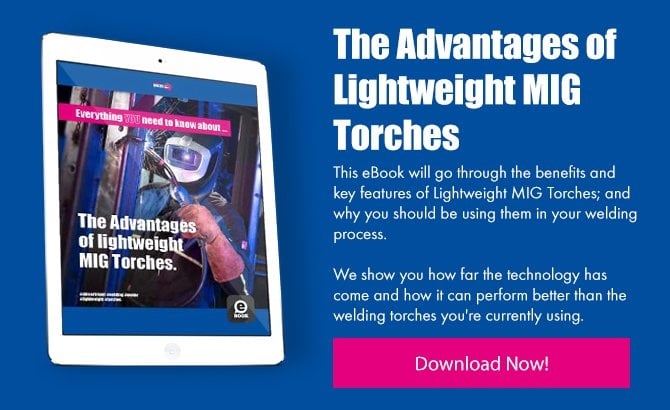Most MIG guns are designed to last. Problem is, a lot of welders and welding professionals don’t believe it. There are ‘problems’ with MIG guns – and specifically lightweight ones. They can have a bad rap, or are misunderstood. Light doesn’t mean weak. In fact, a lot of times it’s just the opposite.
I’ve been showing and demoing lightweight and air-cooled MIG guns for decades. And I hear the same problems and objections almost every time:
-
They Have Less Duty Cycle
-
They're Not Durable
-
Lightweight is Overrated
-
They Aren't Maintenance Friendly
Here I’ll explain those ‘problems’, and how you can overcome them with a little more knowledge about just what goes in to lightweight, and in some cases any, air-cooled MIG guns:
Duty Cycle
You would be surprised how many weld shops I visit and, after talking with the welder’s and shop foreman, I find out that none of them have a clue what duty cycle is. Duty cycle is a key component of productivity. If you aren’t running the correct duty cycle you are going to run in to problems.
Most air-cooled torches are rated at 60% duty cycle; this means that they can run 6 minutes out of every 10.
Depending on your needs, this might work for you. For instance, if you’re a job shop welder that is only welding periodically throughout every hour this is not a problem (usually). If you’re going to be continuously running the torch then you would want something to the tune of a 100% duty cycle such as a water-cooled torch.
Duty Cycle is just as important as determining which amperage and wire size to use for a particular job. Running a 350 amp, 60% duty cycle torch all day at its maximum 350 amp setting means that you probably have the wrong torch, and after welding like that for a while you likely have porosity problems as well as other imperfections in your weld. If you don’t know the correct duty cycle for how much you’re pushing the torch, you risk burning the torch up to the point where it needs repairs, or worse, replacement.
They’re Not Durable
I hear the same thing in almost every shop, that welders beat the torches up daily. I’ve seen welders use them as hammers, throw them down on the ground, and even run them over with forklifts. This means that companies who make the most durable torches thrive – whether they’re lightweight or not.
A lot of lightweight torch designs are made to be lightweight by removing important components of the torch’s durability. For example, some companies might make the handle with thinner, shatter-prone plastic to shave a few ounces off. When that torch is dropped it will crack or shatter into multiple pieces, forcing you to buy a new one. That’s why before you buy a lightweight MIG gun, make sure you look to check durability to see if the handles are shatter-resistant, metal plated/lined, and what plastics they are made of.-Dec-19-2024-06-23-11-8803-PM.png?width=300&height=300&name=Untitled%20design%20(3)-Dec-19-2024-06-23-11-8803-PM.png)
Some companies also make their torches with cheaper, lighter metals. These softer metals, when used on a daily basis, will expand and wear much quicker than if they use hard or plated metals. It is important to be on the lookout for the companies that tell you the materials that make up their torches, so that you are sure you are getting a lightweight, durable torch that will last. If they don’t know or don’t want to tell you, take that as a red flag.
Weight Doesn’t Really Matter
The weight of a torch will really factor into how the workday goes for a welder. If you use the shortest, lightest weight torch possible, then you will take a lot of fatigue and pressure off of the welder’s body. The ABC (Always Be Comfortable) rule really comes into play when discussing lightweight torches that welders will be using for hours on end.
A company that I deal with regularly welds and repairs garbage trucks. It’s a tough job. They go over the trucks, next to the trucks, under the trucks, and even inside the bed of the trucks. It is very important that they stay comfortable while in these tight, strangely angled areas or the weld quality could suffer.
When considering a lightweight MIG gun, look for ones that have features such as ball-socket bases and ergonomic handles, as this takes a lot of stress off of the welder’s wrist and hand.
They're Not Maintenance Friendly
When investing in a lightweight MIG gun be on the lookout for torches that you can repair when they do break. Things like removable necks and threaded nozzles enable the welder to swap burnt out parts on the fly.
You also want to be looking for welding guns that allow you to access the inner workings of the torch so that you can make repairs, instead of having to replace the entire torch. Being able to remove the handle to replace it if it cracks, and the ability to replace burnt up wire connections is always a plus. Don’t think of a lightweight MIG gun as a throwaway item when you can save money by purchasing torches that allow you to quickly repair any issues they have.
A lightweight MIG gun can really boost productivity and make the welder’s life a lot easier, but do your research when looking for them, and don’t undercut the importance of certain features.


